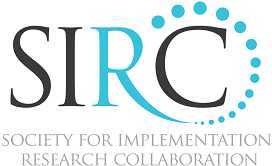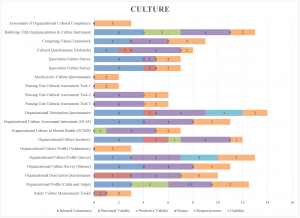|
Culture refers to the norms, values, and basic assumptions of a given organization. |
|
| Culture | |
|
To see the head-to-head comparisons of the evidence-based assessment rating profiles for the instruments listed below, please click here. |
|
|
Assessment of Organizational Cultural Competence (AOCC) AUCD Multicultural Council (2006) |
|
| The Assessment of Organizational Cultural Competence is a 44-item instrument used to identify organizations’ strengths and needs for further training and program developmentto become a more culturally competent organization. | |
|
Baldridge TQM Implementation & Culture Instrument (B TQM IC) Shortell, Jones, et al. (2000) |
|
| The Baldridge TQM Implementation & Culture Instrument is a 58-item instrument that assesses 7 major areas of quality management work in order to differentiate high-performingfrom low-performing organizations in many sectors of the US and global economy. | |
| Competing Values Framework (CVF)
Helfrich et al. 2007; adapted from Shortell et al., 1995; Zammuto & Krakower, 1991) |
|
| The Competing Values Framework (Helfrich) is a 16-item instrument used to assess organizational culture as a predictor of quality improvement implementation, employee andpatient satisfaction, and team functioning in health care facilities. | |
| Culture Questionnaire (CQ) Hofstede et al. (1990) | |
| The Culture Questionnaire is a 135-item instrument that measures organizations based on three values: need for security, importance of work and need for authority. | |
|
Innovation Culture Survey (ICQ) Dobni (2008) |
|
| The Culture Questionnaire is a 135-item instrument that measures organizations based on three values: need for security, importance of work and need for authority. | |
| Mackenzie’s Culture Questionnaire (MCQ) Mackenzie (1995) | |
| Mackenzie’s Culture Questionnaire is a 76-item instrument used to measure organizational culture in terms of 12 dimensions, including employee commitment, management style,openness and trust, teamwork and cooperation, and organizational direction. | |
|
Nursing Unit Cultural Assessment Tool (NUCAT) Coeling & Sims (1993) |
|
| The NUCAT is a 50-item instrument used to identify discrepancies between preferred and actual cultural behaviors of nursing units. | |
| Nursing Unit Cultural Assessment Tool II (NUCAT-2)
Simms et al. (1993) |
|
| The NUCAT–2 is a 50-item instrument used to identify a nursing group’s preferred versus typical behavior; it is designed to measure the responses of a majority of the membersof a nursing group. | |
|
Nursing Unit Cultural Assessment Tool III (NUCAT-3) Coeling |
|
| The NUCAT–3 is a 50-item tool designed to analyze the culture of a specific work group in terms of cultural norms, behaviors and differences. | |
| Organizational Culture Assessment Instrument (OCAI)
Cameron & Quinn (1999) |
|
| The OCAI is a 24-item instrument used to assess 6 key dimensions of organizational culture, such as Organizational Leadership and Strategic Emphases. | |
| Organizational Culture in Mental Health (OCMH)
Waegemakers Schiff (2009) |
|
| The OCMH is a 60-item instrument used to identify a firm’s spoken and unspoken values, attitudes and beliefs about how its members behave. | |
| Organizational Culture Inventory (OCI)
Cooke & Lafferty (1986) |
|
| The Organizational Culture Inventory is a 120-item instrument used to measure behaviors or personal styles that might be expected of members in an organization to “fit in???and “meet expectations.??? | |
| Organizational Culture Profile (revised, Ahkanasy) (OCP; Ashkanasy)
Ashkanasy et al. (2000) |
|
| The 2000 Ashkanasy, et al version of the OCP is a 47-item instrument designed to measure organizational culture based on 10 dimensions, including Leadership, Structureand Innovation. | |
|
Organizational Culture Profile (revised, Cable & Judge) (OCP; Cable) Cable & Judge (1997) |
|
| The 1997 Cable & Judge version of the OCP is a 40-item instrument that measures organizational culture based on participants’ identification with personal characteristicssuch as Adaptability, Fairness, and Decisiveness. | |
| Organizational Culture Profile (OCP; original)
O’Reilly et al. (1991) |
|
| The original OCP is a 54-item instrument used to capture person-organization fit by generically identifying individual and organizational values such as adaptability, integrityand transparency. | |
| Organizational Culture Profile (OCP; Sarros)
Sarros et al. (2005) |
|
| The 2005 Sarros et al version of the OCP is a 28-item instrument used to examine the congruence between individual and organizational values, adapted from the originalinstrument for a sample of Australian managers. | |
| Organizational Culture Survey (OSC/OCU)
Glisson (2000) |
|
| The OCU is a 99-item instrument designed to assess the organizational characteristics and work environments of human service systems. | |
| Organizational Culture Survey (OCS)
Glaser et al. (1987) |
|
| The OCS is a 36-item tool used to identify organizational culture by representing six central foci of culture common to various disciplinary fields and types of corporations,including teamwork, morale and involvement. | |
| Organisational Description Questionnaire (ODQ) Bass & Aviolo (1993) | |
| The ODQ is a 28-item instrument dealing with transactional and transformational elements of a culture’s assumptions, processes and expectations. | |
| Safety Culture Measurement Tool (SCMT)
Mearns et al. (2009) |
|
| The SCMT is a 59-item instrument measuring positive and negative aspects in safety culture of the organization and covers 13 safety culture elements includingCommitment to Safety, Resources for Safety and Regulatory Effectiveness. | |
Disclaimer: Some instrument descriptions were taken directly from articles contained in specific instrument pages.

